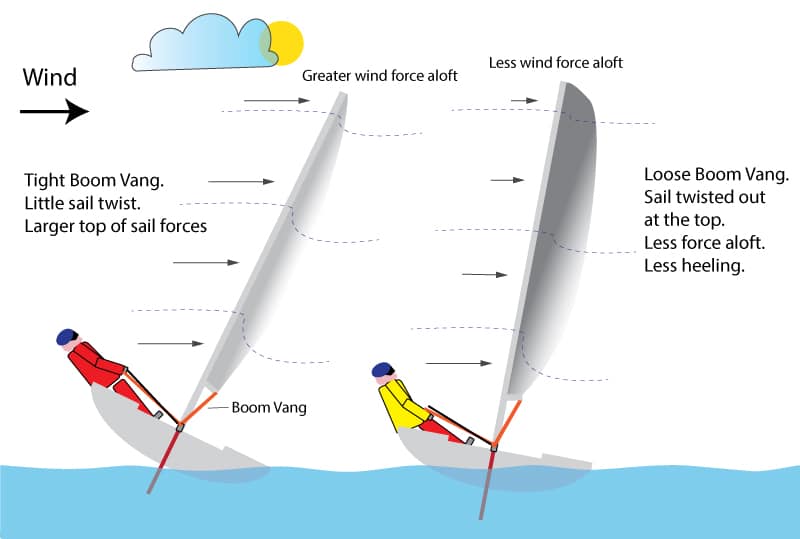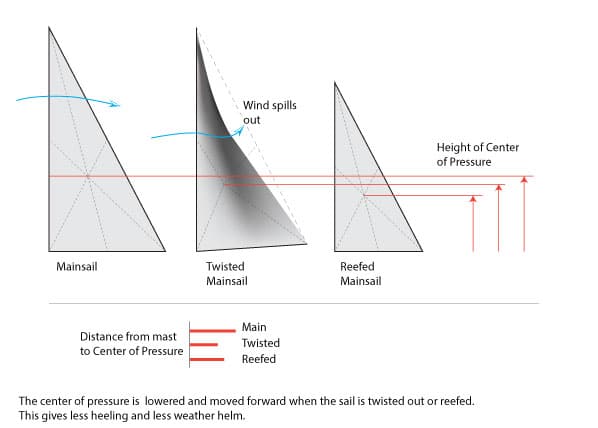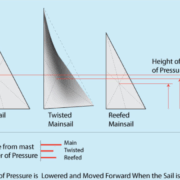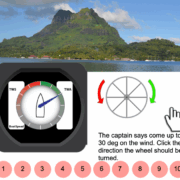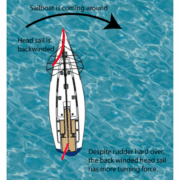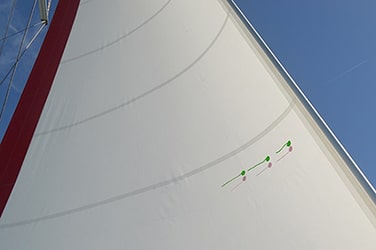
This article is an excerpt from NauticEd’s online FREE Basic Sail Trim Course, an interactive online sailing course for beginner to intermediate sailors to learn the basics of sail trim. Or if you want to learn more, upgrade to the Skipper Course Bundle to become a competent sailor!
You can learn to sail and improve your sailing with NauticEd, the international leader in sailing education.
What is Sail Twist and how to use it?
Put some Twist in your Sails
Managing sail twist can increase the performance, speed, and control of the sails. The goal of this article is to teach you about sail twist and how to effect change to your advantage.
Once you have read the following article, learn more about sail trim in our online Sail Trim course.
First, if you’re rusty on the terms – refresh with the mainsail components diagram.
Since a sail provides its power to the boat from changing the flow direction of the air passing, it is advantageous to be able to control this flow continuously by managing the shape of all points of the sail – from low to high and from front to back.
Controlling the sail shape from front to back is managed by the outhaul, the running backstays, and the halyard. This controls the draft (curve) of the sail which affects the power of the sail – but is not the control means for twist.
Controlling the sail shape from bottom to top is managed by the boom vang, traveler, and the main sheet (also the running backstays have an effect). This controls the twist of the sail which also affects the power of the sail through the vertical height. The primary controller for twist is the boom vang.
Now that you know you want to control twist (because you control power), let’s show you what it is, what it does, and how to effect change.
click to enlarge
What is Sail Twist?
Watch this video clip to see how the mainsail twists out as you observe rising up the leech (back) of the mainsail. Look at the sail batten directions, the top battens (and thus the sail) are more pointed outboard of the boat whereas the bottom battens are more aligned with the centerline of the boat. Watching the flow of air, you’ll see that the air direction towards the top is altered less than the air at the bottom. This is called sail twist. The leech (trailing edge of the sail), starting from the back of the boom, curves outboard the farther up the sail. The sail is said to be “twisted out”.
What Sail Twist does
- Reduces Heeling: The farther the sail leech curves out aloft, the less the airflow direction is altered higher up. This is also called spilling air. This means less force on the sail at the top – which reduces the heeling force at the top. And we know from opening paint cans with a screwdriver, that force applied at a distance gives more force – called “leverage” or “moment”. Thus, reducing the sideways heeling force at the top of the mast is more effective to prevent the boat from heeling over than reducing heeling force at the bottom of the mast. So, sail twist spills out air at the top and moves the driving power of the sail lower down the sail which reduces heeling moment and allows you to maintain a larger sail before having to reef the sail.
- Reduces Weather Helm: Twisting the sail out also moves the center of pressure of the wind acting on the sail forward because there is less sail area aft. This means the wind force on the boat moves forward. Excessive weather helm is created when there is to much wind force acting aft. This makes the boat want to turn up onto the wind. Shifting the center of pressure forward thus reduces weather helm. A more effective way however to more the center of pressure forward is to reef the sail. This effect can be seen in the following graphic.
There is another more complicated phenomenon where sail twist is used. Air velocity as you rise upwards from the surface of the water increases, and since your boat is moving, this means that the apparent wind direction is different at the top of the mast compared to the apparent wind direction at the boom. It is coming from a more aft direction. So having some twist out at the top means you are shaping the sail to meet the direction of the different wind aloft.
An even more complicated effect is that because of wind slowing as it gets near the surface, the Coriolis phenomenon causes the air direction to further change at the top of the mast and this is in the opposite direction when considering the northern hemisphere and southern hemisphere. The difference may not be much, but global professional sailors know this and account for it when trimming sails.
How to change sail twist
Imagine on a light wind day, you put all your body weight on the back of the boom. This would surely pull down on the boom and tighten the mainsail leech (back of the sail). This effectively would prevent the leech from twisting out along its full length from the back of the boom to the top of the mast.
The most effective way to pull down on the back of the boom is to tighten the boom vang. This can also be achieved by using the traveler and the mainsail sheet in combination.
Now watch the full-length video clip where you can see the full effects of changing sail twist using the boom vang.
Some boats don’t have a boom vang. Not a problem! Twist out aloft can be achieved by easing out the main sheet and moving the traveler to windward. This effectively allows the aft of the boom to rise. Additionally, you can reduce sail twist by hauling down on the mainsheet and adjusting the traveler to match your point of sail. e.g. imagine you are on a close reach in light winds and you don’t want to spill out any wind aloft. Ease the traveler down but tighten the main sheet. This brings down the aft of the boom and prevents wind spilling aloft.
Here we discussed the main only. But similar adjustments for efficiency can be done with the head sail (jib or genoa) (quick hint, move the fairlead aft). The NauticEd Sail Trim Clinic covers all aspects of trimming the sails for efficiency. It is $39 of knowledge that will make you look good on the water and give good conversation to your crew while underway. I mean, is anyone a real sailor if they don’t know sail trim?
Add the NauticEd Sail Trim Clinic to your curriculum and sailing resume now.



